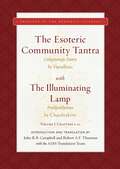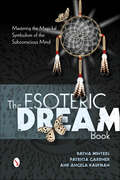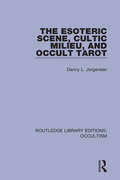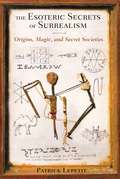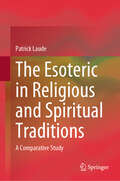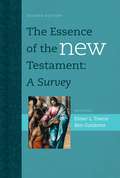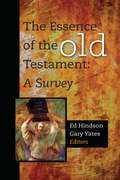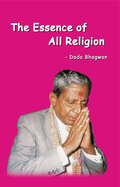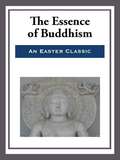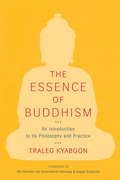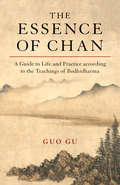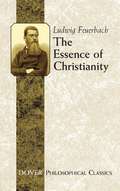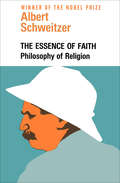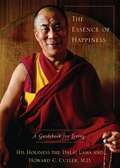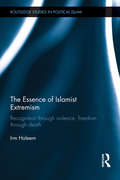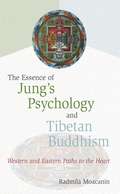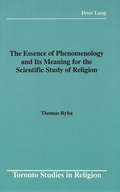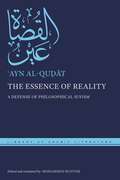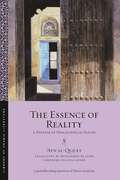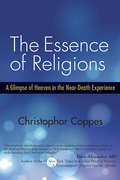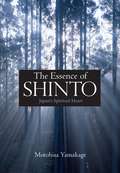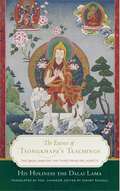- Table View
- List View
The Eschatology of 1 Peter
by Kelly D. LiebengoodThe author of 1 Peter regards Christian suffering as a necessary feature of faithful allegiance to Jesus, which precedes the full restoration and vindication of God's people. Much previous research has explored only the cause and nature of suffering; Kelly D. Liebengood now addresses the need for an explanation for the source that has generated this particular understanding. If Jesus truly is God's redemptive agent, come to restore His people, how can Christian suffering be a necessary part of discipleship after his coming, death and resurrection, and what led the author of 1 Peter to such a startling conclusion? Liebengood analyzes the appropriation of shepherds, exodus, and fiery trials imagery and argues that the author of 1 Peter is dependent upon the eschatological programme of Zechariah 9-14 for his theology of Christian suffering. This book will interest those studying the New Testament, Petrine theology and early Christianity.
The Esoteric Community Tantra with The Illuminating Lamp: Volume I: Chapters 1–12 (Treasury of the Buddhist Sciences)
by Chandrakirti Great VajradharaA new presentation of Tantra with its most renowned commentary by one of the foremost translator/scholar teams of Indian and Tibetan Buddhism.This volume is a translation of the first twelve chapters of The Glorious Esoteric Community Great King of Tantras (Sri Guhyasamaja Maha-tantra-raja), along with the commentary called The Illuminating Lamp (Pradipoddyotana-nama-tika), a commentary in Sanskrit on this tantra by the seventh-century Buddhist intellectual and tantric scholar-adept Chandrakirti. Regarded by Indo-Tibetan tradition as the esoteric scripture wherein the Buddha revealed in greatest detail the actual psycho-physical process of his enlightenment, The Esoteric Community Tantra is a preeminent text of the class of scriptures known to Indian Buddhist scholar-adepts as great yoga tantra, and later to their Tibetan successors as unexcelled yoga tantra. The Illuminating Lamp presents a system of interpretive guidelines according to which the cryptic meanings of all tantras might be extracted in order to engage the ritual and yogic practices taught therein. Applying its interpretive strategies to the text of The Esoteric Community Tantra, The Illuminating Lamp articulates a synthetic, &“vajra vehicle&” (vajrayana) discourse that locates tantric practices and ideals squarely within the cosmological and institutional frameworks of exoteric Mahayana Buddhism.
The Esoteric Dream Book: Mastering the Magickal Symbolism of the Subconscious Mind
by Dayna Winters Patricia Gardner Angela KaufmanEveryone dreams and the dreaming mind speaks in the language of evocative symbols. Now you can interpret dream symbols for the purposes of life enhancement and spiritual growth through this comprehensive guide to esoteric dreaming. Become more open to the messages from the subconscious mind to find solutions to personal problems or gain insight into day-to-day events. Learn how to remember your dreams and how to document them clearly for later interpretation. This book is an in-depth guide to understanding the consequential and multilayered meanings of mundane and arcane dream symbols and provides rituals, spells, and magickal correspondences ideal for dream work.
The Esoteric Scene, Cultic Milieu, and Occult Tarot (Routledge Library Editions: Occultism #3)
by Danny L. JorgensenOriginally published in 1992, The Esoteric Scene, Cultic Milieu, and Occult Tarot examines beliefs, practices, and activities described as mystical, psychical, magical, spiritual, metaphysical, theophysical, esoteric, occult, and/or pagan, among other possible labels, by their American disciplines. The book is comprised using a mixture of field work and interviews and provides a broad overview of the esoteric community and the social meanings of occultism. The book describes and analyses social meanings of ‘esoteric culture’ as it is experienced, defined, structured and enacted by societal members and examines the sociological significance of esoteric culture as a formulation of alternative sociocultural realities. It provides a sociological understanding of esoteric culture and the cultural milieu.
The Esoteric Secrets of Surrealism: Origins, Magic, and Secret Societies
by Bernard Roger Patrick LepetitA profound understanding of the surrealists’ connections with alchemists and secret societies and the hermetic aspirations revealed in their works • Explains how surrealist paintings and poems employed mythology, gnostic principles, tarot, voodoo, alchemy, and other hermetic sciences to seek out unexplored regions of the mind and recover lost “psychic” and magical powers • Provides many examples of esoteric influence in surrealism, such as how Picasso’s Demoiselles d’Avignon was originally titled The Bath of the Philosophers Not merely an artistic or literary movement as many believe, the surrealists rejected the labels of artist and author bestowed upon them by outsiders, accepting instead the titles of magician, alchemist, or--in the case of Leonora Carrington and Remedios Varo--witch. Their paintings, poems, and other works were created to seek out unexplored regions of the mind and recover lost “psychic” and magical powers. They used creative expression as the vehicle to attain what André Breton called the “supreme point,” the point at which all opposites cease to be perceived as contradictions. This supreme point is found at the heart of all esoteric doctrines, including the Great Work of alchemy, and enables communication with higher states of being. Drawing on an extensive range of writings by the surrealists and those in their circle of influence, Patrick Lepetit shows how the surrealists employed mythology, gnostic principles, tarot, voodoo, and alchemy not simply as reference points but as significant elements of their ongoing investigations into the fundamental nature of consciousness. He provides many specific examples of esoteric influence among the surrealists, such as how Picasso’s famous Demoiselles d’Avignon was originally titled The Bath of the Philosophers, how painter Victor Brauner drew from his father’s spiritualist vocation as well as the Kabbalah and tarot, and how doctor and surrealist author Pierre Mabille was a Freemason focused on finding initiatory paths where “it is possible to feel a new system connecting man with the universe.” Lepetit casts new light on the connection between key figures of the movement and the circle of adepts gathered around Fulcanelli. He also explores the relationship between surrealists and Freemasonry, Martinists, and the Elect Cohen as well as the Grail mythos and the Arthurian brotherhood.
The Esoteric in Religious and Spiritual Traditions: A Comparative Study
by Patrick LaudeThis book offers a comparative examination of the esoteric dimension across diverse religions, including Buddhism, Christianity, Hinduism, and Islam. It seeks to answer the question of whether the concept of the esoteric can be applied across traditions and explores intersections, convergences, and differences in its use and presence therein. The book provides new avenues for research by moving beyond the study of Western esotericism and examining how the category of the esoteric can be applied in the contexts of Abrahamic faiths and Asian traditions. The book is organized into six centers of reflection, including the esoteric dialectics of hiding and revealing, the claim of esoteric traditions to restore wholeness and provide a comprehensive understanding of reality, the character of immediacy and directness, the intrinsic esoteric distinction between two truths, and the non-dualistic leanings of esoteric schools in terms of the unity of reality and the subjective immanence of an all-embracing Divine Selfhood. Overall, the book provides a comprehensive phenomenology of the esoteric in religions. It will be of interest to researchers and students of theology and religious studies.
The Essence Of The New Testament: A Survey
by Elmer L. Towns Ben GutierrezThe Essence of the New Testament, Second Edition surveys the books of the New Testament from Matthew to Revelation. Drawing on decades of scholarly research and classroom teaching, the authors provide a practical, readable, and insightful introduction to the second major division of the Christian biblical canon. This new edition contains new information about the emergence of an early Christian canon, the significance of Second Temple Judaism for New Testament study, an overview of tools for New Testament research, an introduction to Jesus studies, and a synopsis of the relationship of the Old Testament to the New Testament.
The Essence Of The Old Testament: A Survey
by Ed Hindson Gary YatesThe Essence of the Old Testament surveys the books from Genesis to Malachi. Based on thirty years of scholarly research and classroom teaching, a team of biblical scholars from Liberty University provides a practical, readable, and insightful introduction to the Hebrew Scriptures in canonical order.
The Essence of All Religion
by Dada BhagwanThose seeking to lead a spiritual life inevitably face challenges in their pursuit of spirituality and practice. As spiritual development progresses, facing one’s faults, failures, and unintentional mistakes become disconcerting – even for the most sincere seeker. One may then ask, “What are the benefits of the different types of religion? From the many religions of the world, which practices will accelerate my spiritual growth? In actuality, how to live exactly?” In the book “The Essence of All Religion”, Gnani Purush (the enlightened One) Dada Bhagwan clarifies any confusion about religion vs. spirituality. Pujya Dadashri offers the essential extract of spiritual science and religion in the form of Nine Kalams (highest spiritual intents). He explains that the Nine Kalams are the essence of the highest teaching of the religions of the world and the simplest, most direct means to live in peace. The spiritual guidance available in this book is both unique and unparalleled.
The Essence of Buddhism
by E. Haldeman-JuliusThis book describes the basic principles of Buddhism. Much has been written about Buddhism and how to practice it. Readers will have no difficulty finding hundreds of books on the topic. This book simply focuses on the essence of Buddhism, as expressed in the Four Noble Truths and the Eight-fold Path. Buddhism is not a religion as such; it does not propose an external God. It does not seek to replace a person's existing religious beliefs, only to supplement them. The Buddha, in all likelihood, would rather his followers describe themselves simply as Followers of The Way.
The Essence of Buddhism: An Introduction to Its Philosophy and Practice
by Sogyal Rinpoche Traleg Kyabgon Ogyen Trinley KarmapaThis comprehensive guide to the Buddhist path from the Tibetan point of view is as accessible as it is complete. Traleg Kyabgon breaks the teachings down conveniently into the three traditional "vehicles," while never letting us forget that the point of all the Dharma is nothing other than insight into the mind and heart. Along the way he provides vivid definitions of fundamental Buddhist concepts such as compassion, emptiness, and Buddha-nature and answers common questions such as: * Why does Buddhism teach that there is "no self"? * Are Buddhist teachings pessimistic? * Does Buddhism encourage social passivity? * What is the role of sex in Buddhist tantra? * Why is it said that samsara is nirvana? * Does it take countless lifetimes to attain enlightenment, or can it be achieved in a moment?
The Essence of Chan: A Guide to Life and Practice according to the Teachings of Bodhidharma
by Guo GuClear and illuminating commentary on one of Bodhidharma's most important texts, designed to help Chan practitioners apply timeless and essential advice to their practice.Legend has it that more than a thousand years ago an Indian Buddhist monk named Bodhidharma arrived in China. His approach to teaching was unlike that of any of the Buddhist missionaries who had come to China before him. He confounded the emperor with cryptic dialogues, traveled the country, lived in a cave in the mountains, and eventually paved the way for a unique and illuminating approach to Buddhist teachings that would later spread across the whole of East Asia in the form of Chan--later to be known as Seon in Korean, Thien in Vietnamese, and Zen in Japanese.This book, a translation and commentary on one of Bodhidharma's most important texts, explores Bodhidharma's revolutionary teachings in English. Guo Gu weaves his commentary through modern and relatable contexts, showing that this centuries-old wisdom is just as crucial for life now as it was when it first came to be. Masterfully translated and accompanied by helpful insights to supplement daily practice, The Essence of Chan is the perfect guide for those new to Chan, those returning, or those who have been practicing for years.
The Essence of Chan: A Practical Guide to Life and Practice according to the Teachings of Bodhidharma
by Guo GuLegend has it that more than a thousand years ago, an Indian Buddhist monk named Bodhidharma arrived in China. His approach to teaching was unlike that of any of the Buddhist practitioners who had come to China before him. Bodhidharma confounded and infuriated the emperor with cryptic dialogues before traveling the country and eventually settling into a cave behind Mount Song, where he meditated for nine years, waiting to transmit his teachings to the right person. He would later be credited as the founder of Chan Buddhism. Bodhidharma had such an impact on Chinese Buddhism because of the directness of his teaching. We are intrinsically free from vexations and afflictions, he taught, and our true nature is already perfect and undefiled. Two Entries and Four Practices is one of the few texts that Bodhidharma composed. This short scripture contains the marrow, or essence, of all his teachings. Chan teacher Guo Gu offers a translation of this significant text, as well as an elaboration on the teachings on life and practice that it presents, which reflect the essence of Chan itself.
The Essence of Christianity
by Ludwig FeuerbachDid God create man? Or did man create God? Famed German philosopher Ludwig Feuerbach explores the answer in this, his most influential work, published in German in 1841 and translated by celebrated English novelist George Eliot. Using Biblical references, dialectics, and ideas from some of the world's greatest thinkers, he confronts believers with his cogent explanation.Approaching religion from a humanistic perspective, Feuerbach explores the idea that divinity is an outward projection of our idealistic human nature. Asserting that nothing is higher than the perfection found in mankind, he proposes that a Supreme Being was created by man seeking comfort and relief from a hostile world, challenging tenets of Christianity from creation and the resurrection to faith and miracles. Feuerbach's critique of Hegelian idealism excited immediate international attention -- influencing Karl Marx, Sigmund Freud, and Friedrich Engels in particular. Thought-provoking and utterly compelling, this historically significant polemic is must reading for lifelong students of religion and philosophy.
The Essence of Faith: Philosophy of Religion
by Albert SchweitzerThe Nobel Peace Prize–winning doctor, theologian, and missionary explores the essence of faith in this masterful early work on Kantian metaphysics. Famous for his medical missionary work in what is now the West African country of Gabon, Albert Schweitzer was an accomplished theologian, philosopher, and international bestselling author. While studying for his PhD at the Sorbonne, Schweitzer developed his views on theology through an analysis of Immanuel Kant&’s philosophy of religion. In The Essence of Faith, Schweitzer explores Kantian ideas to arrive at an inspiring meditation on God, faith, and the limits of human understanding. Both an accessible introduction to Schweitzer&’s theology and a strikingly original approach to Kant&’s writing and thought, The Essence of Faith is a slim volume of profound ideas.
The Essence of Happiness
by Dalai Lama Howard C CutlerThe essence of the iconic book The Art of Happiness distilled into a beautiful new format. The Dalai Lama inspired millions around the world with his wisdom and compassion in The Art of Happiness. Now, in The Essence of Happiness, moving insights from His Holiness are gathered in an elegantly designed keepsake book that makes for a handy and accessible medium for that wisdom. Offering sage advice on defeating day-to-day depression, anxiety, anger, jealousy, and other emotions that get in the way of true happiness, the pages of The Essence of Happiness contain transforming reflections on how to overcome suffering and obstacles to create a fulfilled, joyous life. With its new package, ideal for taking anywhere, The Essence of Happiness is poised to become the handbook for living.
The Essence of Hinduism
by M. K. GandhiThis book is so planned and arrenged that each section naturally leads to the next one. The first chapter examines the moral basis of Hinduism. The nature of the universal Moral Law or Power that sustains the universe is described in the second chapter. How can a seeker come face to face with the Supreme Spirit through faith or trained reason or a judicious combination of both? An answer to this conundrum will be found in the third chapter...
The Essence of Islamist Extremism: Recognition through Violence, Freedom through Death (Routledge Studies in Political Islam)
by Irm HaleemThis book provides a critical and a conceptual analysis of radical Islamist rhetoric drawn from temporally and contextually varied Islamist extremist groups, challenging the popular understanding of Islamist extremism as a product of a ‘clash-of-civilizations’. Arguing that the essence of Islamist extremism can only be accurately understood by drawing a distinction between the radical Islamist explanations and justifications of violence, the author posits that despite the radical Islamist contextualization of violence within Islamic religious tenets, there is nothing conceptually or distinctly Islamic about Islamist extremism. She engages in a critical analysis of the nature of reason in radical Islamist rhetoric, asserting that the radical Islamist explanations of violence are conceptually reasoned in terms of existential Hegelian struggles for recognition (as fundamentally struggles against oppression), and the radical Islamist justifications of violence are conceptually reasoned in terms of moral consequentialism. With a detailed analysis of Islamist extremist discourse spanning a wide range of contexts, this book has a broad relevance for scholars and students working in the field of Islamic studies, religious violence, philosophy and political theory.
The Essence of Jung's Psychology and Tibetan Buddhism
by Radmila MoacaninThe Essence of Jung's Psychology and Tibetan Buddhism cuts to the heart of two very different yet remarkably similar traditions. The author touches on many of their major ideas: the collective unconscious and karma, archetypes and deities, the analyst and the spiritual friend, and mandalas. Within Tibetan Buddhism she focuses on tantra and relates its emphasis on spiritual transformation, also a major concern of Jung. This expanded edition includes new material on the integration of the two traditions, and the importance of these paths of the heart in today's unsteady world.
The Essence of Phenomenology and Its Meaning for the Scientific Study of Religion
by Thomas RybaReligious studies is rife with confusion over what the phenomenology of religion is. Conventional approaches dwell on the dissimilarity of the meanings of 'phenomenology' and 'phenomenology of religion' and ignore their synonymy. The purpose of this book is to challenge this trend by examining seven significant historical examples of philosophical phenomenology in order to develop a synthetic definition of 'phenomenology' which will both resolve the perceived conflicts in meaning and lead to a useful augmentation of religious methodology.
The Essence of Reality: A Defense of Philosophical Sufism (Library of Arabic Literature #80)
by ʿAyn al-QuḍātA groundbreaking exposition of Islamic mysticismThe Essence of Reality was written over the course of just three days in 514/1120, by a scholar who was just twenty-four. The text, like its author ʿAyn al-Quḍāt, is remarkable for many reasons, not least of which that it is in all likelihood the earliest philosophical exposition of mysticism in the Islamic intellectual tradition. This important work would go on to exert significant influence on both classical Islamic philosophy and philosophical mysticism.Written in a terse yet beautiful style, The Essence of Reality consists of one hundred brief chapters interspersed with Qurʾanic verses, prophetic sayings, Sufi maxims, and poetry. In conversation with the work of the philosophers Avicenna and al-Ghazālī, the book takes readers on a philosophical journey, with lucid expositions of questions including the problem of the eternity of the world; the nature of God’s essence and attributes; the concepts of “before” and “after”; and the soul’s relationship to the body. All these discussions are seamlessly tied into ʿAyn al-Quḍāt’s foundational argument—that mystical knowledge lies beyond the realm of the intellect.A bilingual Arabic-English edition.
The Essence of Reality: A Defense of Philosophical Sufism (Library of Arabic Literature)
by ʿAyn al-QuḍātA groundbreaking exposition of Islamic mysticism The Essence of Reality was written over the course of just three days in 514/1120, by a scholar who was just twenty-four. The text, like its author ʿAyn al-Quḍāt, is remarkable for many reasons, not least of which that it is in all likelihood the earliest philosophical exposition of mysticism in the Islamic intellectual tradition. This important work would go on to exert significant influence on both classical Islamic philosophy and philosophical mysticism. Written in a terse yet beautiful style, The Essence of Reality consists of one hundred brief chapters interspersed with Qurʾanic verses, prophetic sayings, Sufi maxims, and poetry. In conversation with the work of the philosophers Avicenna and al-Ghazālī, the book takes readers on a philosophical journey, with lucid expositions of questions including the problem of the eternity of the world; the nature of God’s essence and attributes; the concepts of “before” and “after”; and the soul’s relationship to the body. All these discussions are seamlessly tied into ʿAyn al-Quḍāt’s foundational argument—that mystical knowledge lies beyond the realm of the intellect.An English-only edition.
The Essence of Religions
by Christophor CoppesAs we move away from worn-out dogma from both the religious and scientific realms toward a contemporary synthesis of understanding about our existence, Christophor's refreshing and comprehensive analysis of major religions in light of the profound lessons from numerous NDE journeyers offers a rich new tapestry of understanding that I find most valuable.
The Essence of Shinto: Japan's Spiritual Heart
by Motohisa YamakageIn The Essence of Shinto, revered Shinto master Motohisa Yamakage explains the core values of Shinto and explores both basic tenets and its more esoteric points in terms readily accessible to the modern Western reader. He shows how the long history of Shintoism is deeply woven into the fabric of Japanese spirituality and mythology--indeed, it is regarded as Japan’s very spiritual roots--and discusses its role in modern Japan and the world. He also carefully analyzes the relationship of the spirit and the soul, which will provide informed and invaluable insight into how spirituality affects our daily existence. Through the author’s emphasis on the universality of Shinto and its prevalence in the natural world, the book will appeal to all readers with an appreciation of humanity’s place in nature and the individual’s role in the larger society.
The Essence of Tsongkhapa's Teachings: The Dalai Lama on the Three Principal Aspects of the Path
by Dalai LamaLearn from the Dalai Lama the three steps to awakening: 1) renunciation, 2) the awakening mind, and 3) emptiness.His Holiness the Dalai Lama’s commentary on Tsongkhapa’s Three Principal Aspects of the Path helps us integrate the full Buddhist path into our own practice. His Holiness offers a beautiful elucidation of the three aspects of the path: true renunciation based on the wish for freedom, the altruistic awakening mind ( bodhichitta ), and the correct view of emptiness. These three aspects of the path are the axis of all the practices of both sutra and tantra, and they encapsulate Tsongkhapa’s vision of the Buddhist path in its entirety. In their absence, it is impossible for us to develop the great compassion that aspires to liberate other sentient beings from samsara and we will not be able to go beyond this cycle of existence. Practitioners will find The Three Principal Aspects of the Path invaluable as a manual for daily meditation. The universal and timeless insights of this text speak to contemporary spiritual aspirants, East and West. The root verses are presented in both Tibetan and English translation to accompany these profound teachings.

